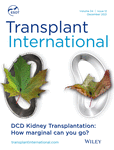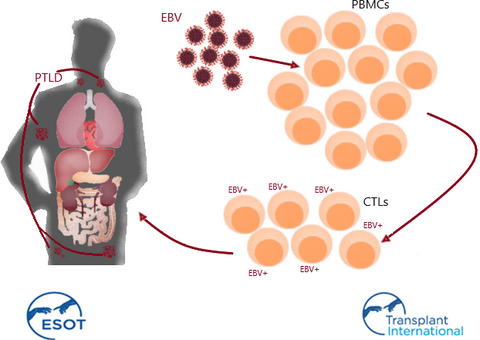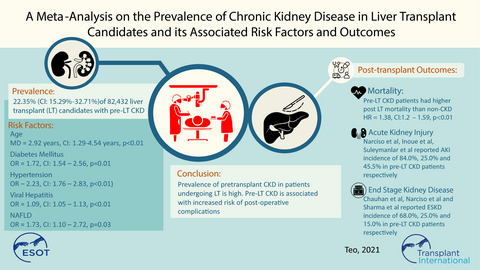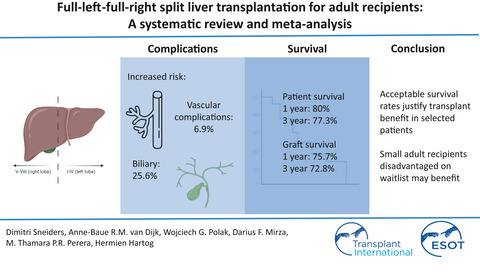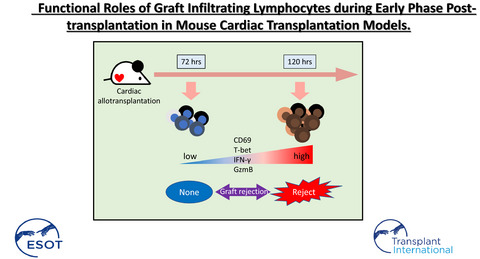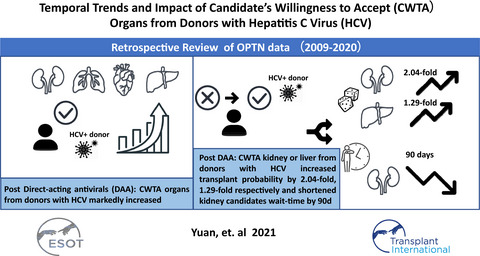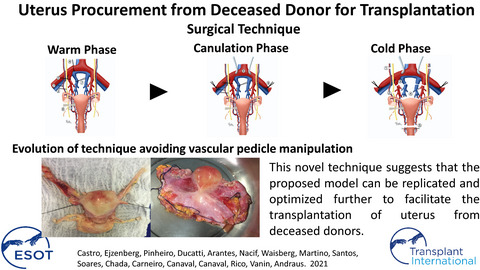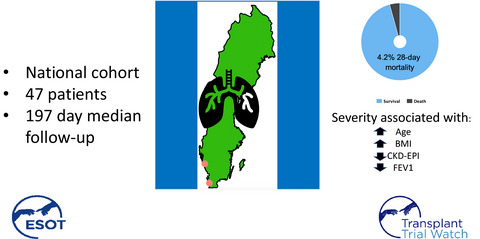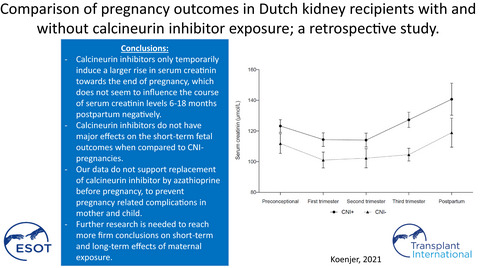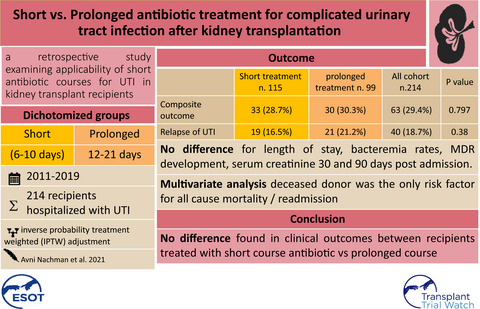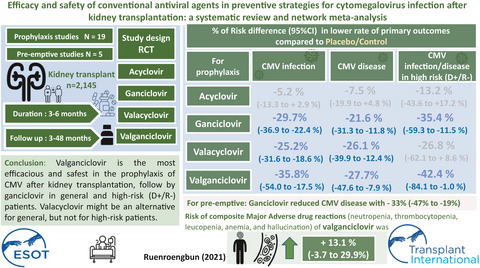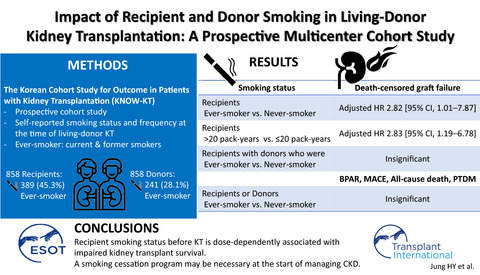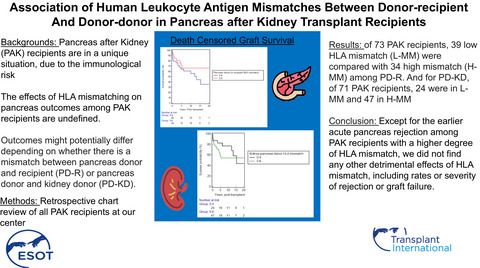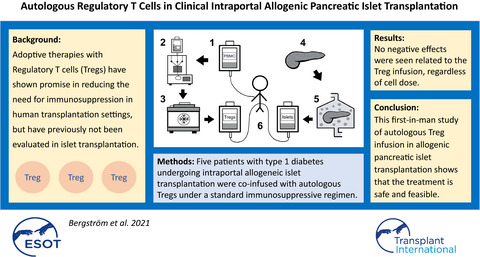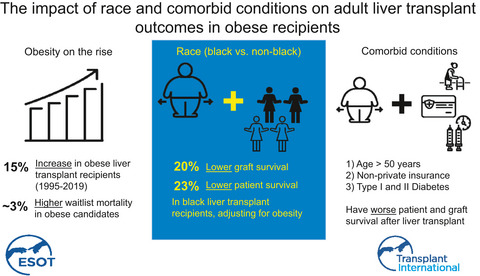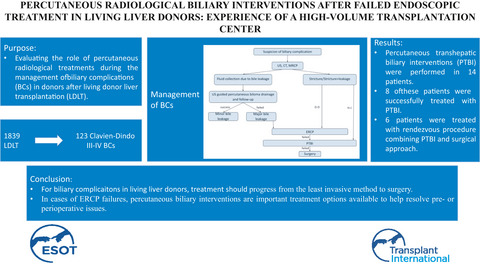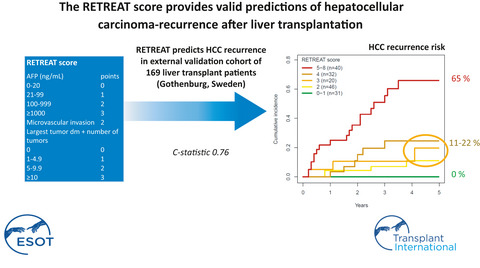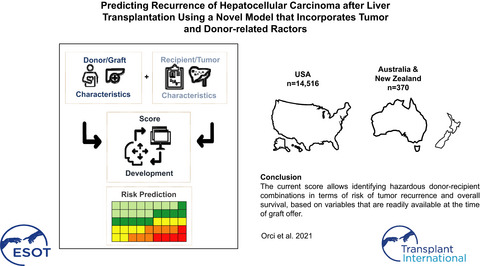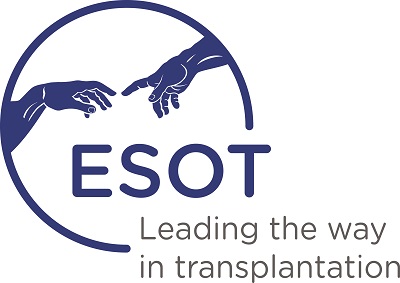Journal list menu
Export Citations
Download PDFs
Issue Information
POINT OF VIEW
Biomarkers as diagnostic tests for delayed graft function in kidney transplantation
- Pages: 2431-2441
- First Published: 09 October 2021
REVIEWS IN CLINICAL TRANSPLANTATION
Chemotherapy, targeted therapy and immunotherapy: Which drugs can be safely used in the solid organ transplant recipients?
- Pages: 2442-2458
- First Published: 23 September 2021
Addressing ethical confusion in deceased donation and transplantation research: the need for dedicated guidance
- Pages: 2459-2468
- First Published: 13 September 2021
Steroid withdrawal after heart transplantation in adults
- Pages: 2469-2482
- First Published: 20 October 2021
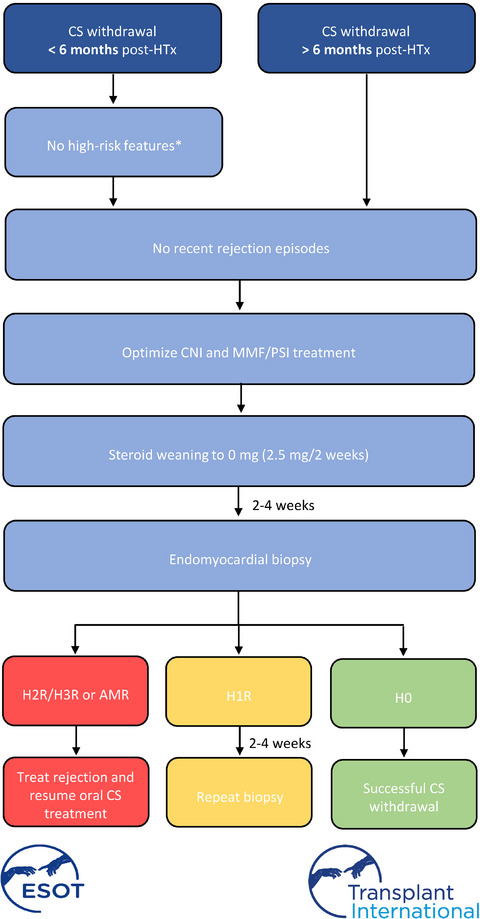
While corticosteroids are a key component of immunosuppressive treatment after heart transplantation, several adverse effects are associated with long-term use and may compromise post-transplant outcome. To address the lack of consensus on corticosteroid withdrawal, this review evaluates different approaches in relation to clinical outcomes.
EBV-specific cytotoxic T lymphocytes for refractory EBV-associated post-transplant lymphoproliferative disorder in solid organ transplant recipients: a systematic review
- Pages: 2483-2493
- First Published: 12 September 2021
COVER ARTICLES
Deciphering transplant outcomes of expanded kidney allografts donated after controlled circulatory death in the current transplant era. A call for caution
- Pages: 2494-2506
- First Published: 09 October 2021
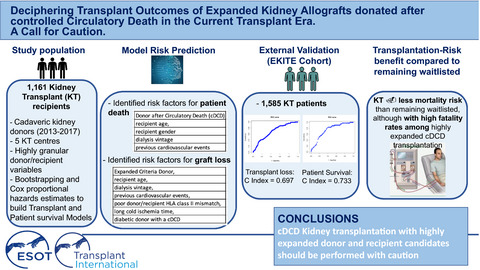
This study presents two prediction models for graft and patient survival using granular data. Even in the worst risk-prediction scenario, KT seems to provide better patient survival expectancy as compared with remaining on the waiting list but with a high mortality risk if this high-risk kidney transplantation is undertaken.
Kidney transplant outcomes in elderly recipients with controlled donation after circulatory death or donation after brain death donors: a registry cohort study
- Pages: 2507-2514
- First Published: 19 October 2021
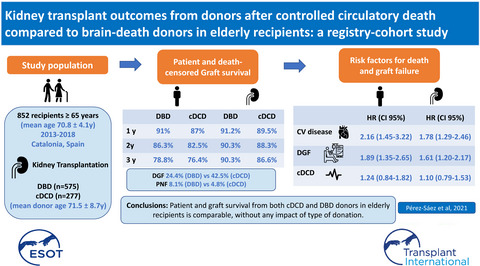
A total of 852 KT recipients aged ≥65 years (575 from DBD and 277 from cDCD) were included in the analysis. The 3-year patient and death-censored graft survival rates were similar between DBD and cDCD-KT (78.8% vs. 76.4% and 90.3% vs. 86.6%, respectively). Cardiovascular disease and DGF were independent risk factors for patient death. The type of donation (cDCD vs. DBD) did not impact in patient survival/graft loss.
META-ANALYSIS
A meta-analysis on the prevalence of chronic kidney disease in liver transplant candidates and its associated risk factors and outcomes
- Pages: 2515-2523
- First Published: 13 November 2021
A meta-analysis of the cumulative incidence, risk factors, and clinical outcomes associated with chronic kidney disease after liver transplantation
- Pages: 2524-2533
- First Published: 29 October 2021
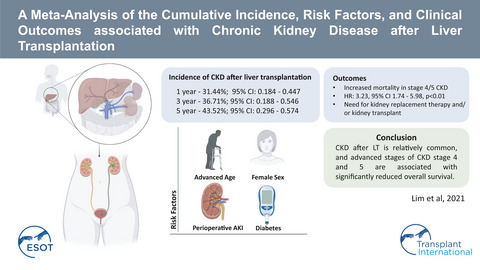
Cumulative incidence of chronic kidney disease (CKD) increased from 31.44% at 1-year to 43.52% at 5-years after LT. Age, female sex, diabetes, and peri-operative acute kidney injury were significant risk factors for CKD. Importantly, stage 4–5 CKD was associated with significantly lower overall survival (HR 3.23, 95% CI 1.74–5.98, P < 0.01).
Full-left-full-right split liver transplantation for adult recipients: a systematic review and meta-analysis
- Pages: 2534-2546
- First Published: 13 November 2021
ORIGINAL ARTICLES: BASIC RESEARCH
Functional roles of graft-infiltrating lymphocytes during early-phase post-transplantation in mouse cardiac transplantation models
- Pages: 2547-2561
- First Published: 23 October 2021
ORIGINAL ARTICLES: CLINICAL RESEARCH
Temporal trends and impact of willingness to accept organs from donors with hepatitis C virus
- Pages: 2562-2569
- First Published: 02 November 2021
Uterus procurement from deceased donor for transplantation
- Pages: 2570-2577
- First Published: 20 October 2021
Quality of life and patient satisfaction with outpatient care after heart transplantation in adult and pediatric patients – room for improvement?
- Pages: 2578-2588
- First Published: 28 October 2021
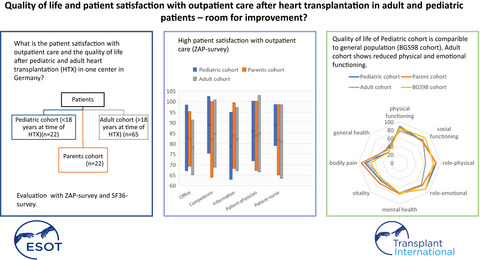
The patient satisfaction with outpatient care is high after heart transplantation in Germany. The quality of life of patients after pediatric heart transplantation is comparable with a standardized German population. Patients after adult heart transplantation show reduced physical and emotional functioning.
Exercise capacity, muscle strength and objectively measured physical activity in patients after heart transplantation
- Pages: 2589-2596
- First Published: 13 October 2021
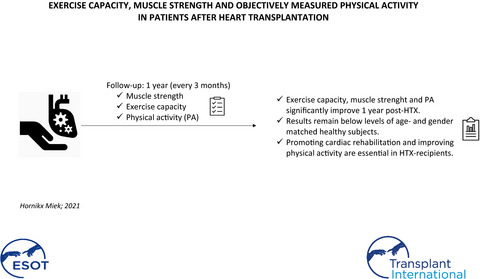
Exercise capacity, muscle strength and physical activity of patients after heart transplantation significantly improve during the first year after surgery. However, results remain below levels of age-and gender matched healthy subjects. Promoting cardiac rehabilitation and improving physical activity in this patient group are essential.
COVID-19 in lung transplant recipients: an overview of the Swedish national experience
- Pages: 2597-2608
- First Published: 28 October 2021
Lung transplantation from uncontrolled and controlled donation after circulatory death: similar outcomes to brain death donors
- Pages: 2609-2619
- First Published: 27 September 2021
Significance of phenotype change after chronic lung allograft dysfunction onset
- Pages: 2620-2632
- First Published: 08 November 2021

We assessed the prevalence and prognostic implications of post CLAD onset phenotype transitions in a large cohort of lung transplant recipients. We have shown that CLAD patients who later changed their phenotype due to the appearance of RAS-like opacities had a significantly worse outcome. Potential event leading to these changes also described.
Outcomes with alemtuzumab induction therapy in lung transplantation: a comprehensive large-scale single-center analysis
- Pages: 2633-2643
- First Published: 04 November 2021

This single-center study represents the first large-scale analysis of long-term outcomes of alemtuzumab induction therapy, followed by a low-dose dual drug maintenance immunosuppression after lung transplantation. The results presented in the manuscript show excellent long-term outcomes, with low rates of severe infections and malignancies.
The beneficial effect of providing kidney transplantation information on transplantation status differs between for-profit and nonprofit dialysis centers
- Pages: 2644-2668
- First Published: 02 November 2021
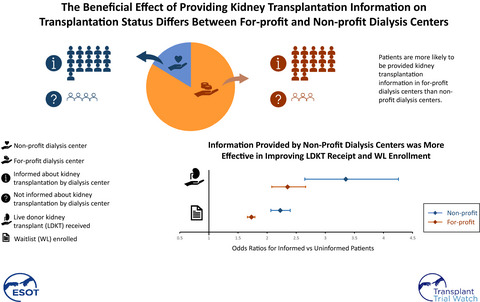
Although informing end-stage kidney disease patients about kidney transplantation options increased the likelihood of choosing these options, information provided by for-profit centers were less effective than those provided by nonprofit centers. Developing standardized guidelines for providing consistent transplantation information is critical.
Comparison of pregnancy outcomes in Dutch kidney recipients with and without calcineurin inhibitor exposure: a retrospective study
- Pages: 2669-2679
- First Published: 19 November 2021
Implementing a regional standardized BK polyomavirus screening protocol across eleven transplant centres
- Pages: 2680-2685
- First Published: 10 October 2021
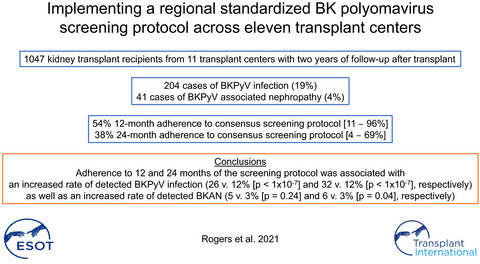
A BK polyomavirus (BKPyV) screening protocol was implemented across 11 transplant centers. Adherence to the screening protocol was low, but was positively correlated with both an increase in the detection of BKPyV infection as well as an unexpected increase in the diagnosis of BKPyV associated nephropathy.
Short versus prolonged antibiotic treatment for complicated urinary tract infection after kidney transplantation
- Pages: 2686-2695
- First Published: 20 October 2021
Sequential genetic testing of living-related donors for inherited renal disease to promote informed choice and enhance safety of living donation
- Pages: 2696-2705
- First Published: 10 October 2021

Living kidney donors may be pre-symptomatic but at risk for the genetic disorder affecting their related transplant recipient. We report an optimized workflow to assess genetic disease in transplant recipients, then using that information to perform focused screening of the related living donor, thus improving their informed choice and safety.
ABO-incompatible kidney transplantation in perspective of deceased donor transplantation and induction strategies: a propensity-matched analysis
- Pages: 2706-2719
- First Published: 22 October 2021
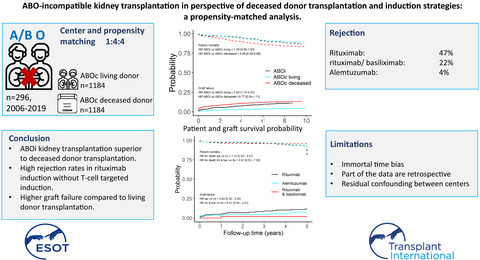
ABO-incompatible kidney transplantation has better patient survival than matched deceased donor transplantation, however with inferior graft survival as compared to matched living donor ABO-compatible transplantation. Rejection rates differ according to induction therapy, and graft survival differs according to blood group titers.
Efficacy and safety of conventional antiviral agents in preventive strategies for cytomegalovirus infection after kidney transplantation: a systematic review and network meta-analysis
- Pages: 2720-2734
- First Published: 27 September 2021
Small donors for small recipients – excellent growth and long-term function of single kidney grafts
- Pages: 2735-2745
- First Published: 09 October 2021
Comparative survival of elderly renal transplant recipients with a living donor versus a deceased donor: A retrospective single center observational study
- Pages: 2746-2754
- First Published: 09 October 2021
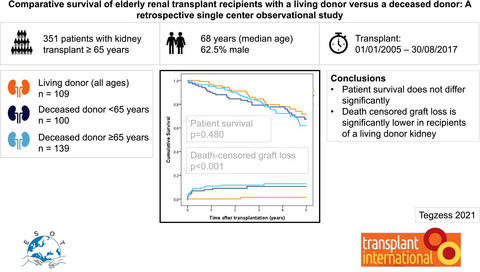
Increasing numbers of elderly (≥65 years) patients are listed for kidney transplantation. In elderly recipients the patient survival benefits of a living donor kidney are limited, but there is decreased death-censored graft loss for these recipients. Nevertheless, graft survival for recipients with a deceased donor remains satisfactory.
Pre-transplant donor-specific HLA antibodies and risk for poor first-year renal transplant outcomes: results from the Swiss Transplant Cohort Study
- Pages: 2755-2768
- First Published: 24 September 2021
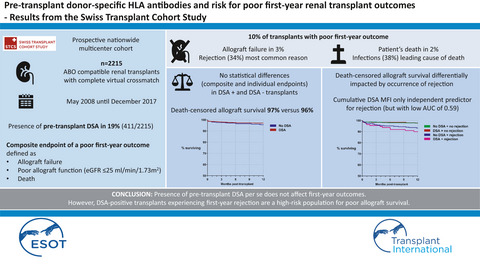
In this nationwide prospective multicenter cohort, 10% of transplants showed a poor first-year outcome. Presence of pre-transplant DSA per se did not affect first year outcomes. However, occurrence of first year rejection in DSA-positive transplants was, in contrast to those without rejection, associated with a poor allograft survival.
Declining trend of preemptive kidney transplantation and impact of pretransplant dialysis: a Korean nationwide prospective cohort study
- Pages: 2769-2780
- First Published: 11 October 2021
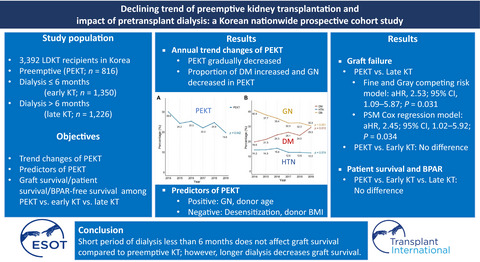
Preemptive KT declined over successive years in Korea. The proportion of diabetes increased and that of glomerulonephritis decreased among preemptive KT. Short period of dialysis less than 6 months does not affect graft survival compared with preemptive KT; however, longer dialysis decreases graft survival.
Impact of technology-based interventions on linking potential kidney donors and transplant candidates: a scoping review
- Pages: 2781-2793
- First Published: 12 October 2021
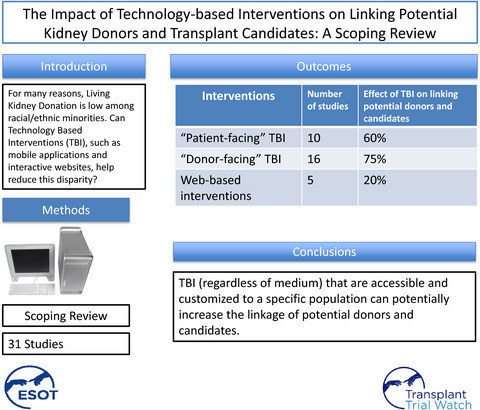
Living kidney donation is underutilized in the United States particularly in minorities and technology-based interventions (TBI) such as mobile applications and interactive websites may help reduce this disparity. In our scoping review, we determined that TBI may serve as a way to connect potential donors and transplant candidates.
Impact of recipient and donor smoking in living-donor kidney transplantation: a prospective multicenter cohort study
- Pages: 2794-2802
- First Published: 12 October 2021
Association of human leukocyte antigen mismatches between donor-recipient and donor-donor in pancreas after kidney transplant recipients
- Pages: 2803-2815
- First Published: 13 October 2021
Autologous regulatory T cells in clinical intraportal allogenic pancreatic islet transplantation
- Pages: 2816-2823
- First Published: 17 November 2021
Post-liver transplantation chronic kidney disease is associated with increased cardiovascular disease risk and poor survival
- Pages: 2824-2833
- First Published: 05 November 2021
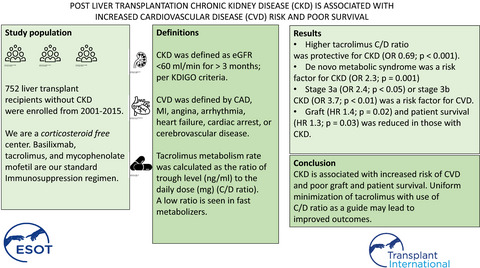
Chronic kidney disease (CKD) is common following liver transplantation. We investigated risk factors, and impact of CKD on cardiovascular disease (CVD), graft/patient survival. A higher tacrolimus concentration to dose ratio was protective for CKD (OR 0.69). CKD led to increased post-transplant CVD (26% vs. 16%), and reduced graft/patient survival.
The impact of race and comorbid conditions on adult liver transplant outcomes in obese recipients
- Pages: 2834-2845
- First Published: 27 September 2021
Percutaneous radiological biliary interventions after failed endoscopic treatment in living liver donors: experience of a high-volume transplantation center
- Pages: 2846-2855
- First Published: 24 September 2021
Extreme hyponatremia as a risk factor for early mortality after liver transplantation in the MELD-sodium era
- Pages: 2856-2868
- First Published: 27 September 2021
The RETREAT score provides valid predictions regarding hepatocellular carcinoma recurrence after liver transplantation
- Pages: 2869-2874
- First Published: 14 November 2021
Predicting recurrence of hepatocellular carcinoma after liver transplantation using a novel model that incorporates tumor and donor-related factors
- Pages: 2875-2886
- First Published: 16 November 2021
Safety of intra-operative blood salvage during liver transplantation in patients with hepatocellular carcinoma, a propensity score-matched survival analysis
- Pages: 2887-2894
- First Published: 01 November 2021
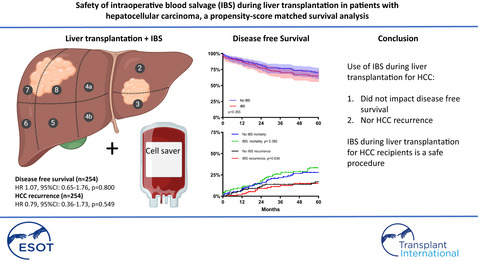
Intraoperative blood salvage (IBS) reduces the use of allogeneic blood transfusion. However, safety of IBS during liver transplantation (LT) for hepatocellular carcinoma (HCC) is questioned due to fear for dissemination of circulating malignant cells. Based in present propensity score matched analysis, IBS during LT did not increase the risk for HCC recurrence.
TRANSPLANT QUIZ
Recurrent proteinuria with graft dysfunction: a diagnostic and clinical conundrum
- Pages: 2895-2896
- First Published: 30 December 2021
LETTER TO THE EDITORS
Gender distribution among transplant journal editorial members: a call to empower women in academic medicine
- Pages: 2897-2898
- First Published: 24 September 2021
Increased rejection rates in kidney transplantations during the COVID-19 pandemic
- Pages: 2899-2902
- First Published: 23 September 2021
Endoscopic ultrasound guided portal-systemic pressure gradient measurement to determine candidacy for kidney transplant alone versus combined liver kidney transplant in patients with advanced fibrosis or cirrhosis
- Pages: 2903-2904
- First Published: 12 September 2021
Toward a novel evidence-based definition of early allograft failure in the perspective of liver retransplant
- Pages: 2905-2907
- First Published: 16 November 2021
The Glissonian stitch traction for biliary duct manipulation in living donor liver transplantation
- Pages: 2908-2909
- First Published: 08 November 2021
TRANSPLANT QUIZ
Recurrent proteinuria with graft dysfunction: a diagnostic and clinical conundrum
- Pages: 2910-2912
- First Published: 27 September 2021
ACKNOWLEDGEMENTS TO REVIEWERS
Acknowledgements to reviewers
- Pages: 2913-2917
- First Published: 30 December 2021




